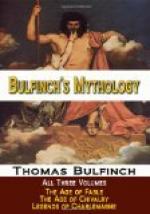[Footnote: Several cities are allotted to King Arthur by the romance-writers. The principal are Caerleon, Camelot, and Carlisle.
Caerleon derives its name from its having been the station of one of the legions, during the dominion of the Romans. It is called by Latin writers Urbs Legionum, the City of Legions. The former word being rendered into Welsh by Caer, meaning city, and the latter contracted into lleon. The river Usk retains its name in modern geography, and there is a town or city of Caerleon upon it, though the city of Cardiff is thought to be the scene of Arthur’s court. Chester also bears in Welsh the name of Caerleon; for Chester, derived from castra, Latin for camp, is the designation of military headquarters.
Camelot is thought to be Winchester.
Shalott is Guilford.
Hamo’s Port is Southampton.
Carlisle is the city still retaining that name, near the Scottish border. But this name is also sometimes applied to other places, which were, like itself, military stations.]
Ambassadors were then sent into several kingdoms, to invite to court the princes both of Gaul and of the adjacent islands. Accordingly there came Augusel, king of Albania, now Scotland, Cadwallo, king of Venedotia, now North Wales, Sater, king of Demetia, now South Wales; also the archbishops of the metropolitan sees, London and York, and Dubricius, bishop of Caerleon, the City of Legions. This prelate, who was primate of Britain, was so eminent for his piety that he could cure any sick person by his prayers. There were also the counts of the principal cities, and many other worthies of no less dignity.
From the adjacent islands came Guillamurius, king of Ireland, Gunfasius, king of the Orkneys, Malvasius, king of Iceland, Lot, king of Norway, Bedver, the butler, Duke of Normandy, Kay, the sewer, Duke of Andegavia; also the twelve peers of Gaul, and Hoel, Duke of the Armorican Britons, with his nobility, who came with such a train of mules, horses, and rich furniture as it is difficult to describe. Besides these there remained no prince of any consideration on this side of Spain who came not upon this invitation. And no wonder, when Arthur’s munificence, which was celebrated over the whole world, made him beloved by all people.




